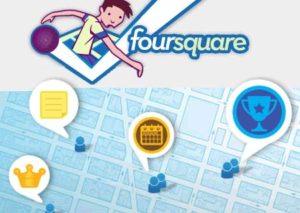
As I interviewed candidates for GrubHub’s Marketing Engagement Manager position, the topic of foursquare came up often. Naturally so, as their platform popularized the application of game mechanics to develop engagement of users on websites and mobile apps. But what many people don’t realize is that foursquare’s engagement strategy is much more than badges and mayorships. The evolution of the product is a great example of a long-term engagement strategy.
So I had our job candidates walk me through what their engagement strategy has been from the launch of the application until today. Our interview candidates provided some fantastic analysis of their tactics with very little prompting from myself, so I thought I’d show case what I plus a few interview candidates described as the evolution of foursquare’s engagement strategy (portions of this program not affecting the outcome have been omitted for brevity’s sake).
![]() Stage 1
Stage 1
Start Time: March 2009
Tactic: Badges
Target audience: Early adopters
Scenario: So, an early adopter has this app which lets him check-in to venues to let his friends know where he is. He’s out and about a lot and so are his friends. But most of his friends don’t use foursquare yet. So why should he bother? Well, early adopters value being the first to hear about and use new services. What appeals to them is status. Unlocked badges provide that status. Discovering badges before others create bragging rights. Since unlocking badges broadcasts that activity to Twitter by default, this serves as a great online sharing tool.
![]() Stage 2
Stage 2
Start Time: March – May 2009
Tactic: Mayorships
Target audience: Early adopters
Mayorships launched during the same time as badges, but they play a larger role later in the diffusion process. After the early adopter and his friends unlock all of the badges, those badges cease to represent the status they used to represent. They also fail to reward checking in to the same place more than once. Mayorships are even more exclusive rewards that not only need to be unlocked, but also maintained by continuing to check in frequently. Mayorships also add an element of competition, since a venue can have only one mayor at a time. This competition and even more exclusive status keeps the early adopter coming back. Mayorships also serve another purpose. While they fuel online sharing just as badges do, they also are more likely to fuel offline sharing, particularly to the local businesses themselves e.g. “I should get a free drink here. I’m the mayor after all.” This is first reported as happening on May 26th of 2009.
![]()
Stage 3
Start Time: January 2010
Tactics: Special Branded Badges
Target audience: Brands, Early adopters, Early majority
Post-funding Twitter no doubt received some good advice form angel investor Jack Dorsey about the success brands were having on Twitter not only themselves, but for Twitter by driving awareness and new usage. On the heels of this, foursquare, thanks to its business development virtuoso Tristan Walker, started partnering with brands for branded, unlocked badges. The brands promote foursquare to new audiences (I doubt many Bravo! watchers were on the service previously), and brands develop a positive appeal with the early adopters already on the service. This tactic provides the early adopters with some much needed new badges to attain, as they have all the old badges, and mayorships have gotten too competitive in some cases. This tactic also provides foursquare with some revenue.
![]()
Stage 4
Start Time: April 2010
Tactic: Specials
Target audience: Local Businesses + Early majority
With mayorships requiring so much effort, local businesses wanted to offer rewards to those bestowed the title of mayor. Previous to this tactic, foursquare could add specials manually, but in April of 2010, they launched a platform for engagement of local businesses to create their own rewards within the foursquare platform. Local establishments could offer specials for the mayor as well as for other check-ins. This engaged local business, who saw an opportunity to create loyalty without a complicated system. This also incentivized check-ins for an early majority for which the non-physical, status-based rewards of badges and mayorships had little appeal, and who didn’t have a need to inform their friends of where they were. Specials make foursquare a viable one player game without using game mechanics.
![]()
Stage 5
Start Time: March 2011
Tactic: Personalized Recommendations
Target audience: Majority
As check-ins become a commodity, and as daily deals become more and more local, foursquare knows they can’t outdeal the competition for the hearts of consumers. But all of these engagement strategies are paying off, as foursquare has now amassed a large database of check-in data it can use to power a new personalized recommendation system. Instead of telling foursquare where you are, it can now tell you where you should go, based on your check-in history and those like you, creating a much larger value proposition than letting your friends know where you are.
Stage 6
Start Time: ?
Tactic: ?
Target audience: World domination
So with this next, yet to be defined stage, I asked our interview candidates to suggest where foursquare might go next to engage its user base in its quest for world domination. The answers were fairly similar, and revolved around the concept of the combination of steps 4 and 5 in a proactive way. One could describe it as push-notified, personalized recommendations for local deals. With the launch of Groupon Now, if this is where they want to go, they better hurry.